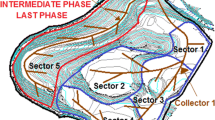Abstract
Aeration of municipal landfills contributes to the acceleration of organic matter degradation and to the decrease of pollutant emission into air, water, and soil. Biodegradation of organic matter present in municipal waste, deposited in a landfill, by microorganisms under anaerobic conditions is a slow process. The aim of the study was to carry out simulations of an aerobic landfill in lysimeters, to determine the influence of aeration rate on the degradation of organic matter present in landfills, and to formulate a mathematical model defining the changes of carbon content in leachate and in gas produced. In this work, simulation of aerobic landfill leachate degradation was carried out in laboratory scale lysimeters with the working volume of 15 L. The changes of BOD5, COD, and ammonium nitrogen concentration during aeration were similar for all aeration rates. During aeration, the BOD5 index decreased by 99.9 %, COD decreased by 95.1 %, and ammonium nitrogen concentration by 93 %. The proposed kinetic model defines the processes of organic carbon content changes in simulated leachate and the quantity of carbon dioxide for aerobic landfill simulation quite well.
Similar content being viewed by others
References
APHA Standard Methods (1992). Standard methods for the examination of water and wastewater (18th ed.). Washington, D.C., USA: American Public Health Association.
Bilgili, M. S., Demir, A., & Özkaya, B. (2007). Influence of leachate recirculation on aerobic and anaerobic decomposition of solid wastes. Journal of Hazardous Materials, 143, 177–183. DOI: 10.1016/j.jhazmat.2006.09.012.
Bilgili, M. S., Demir, A., & Özkaya, B. (2006). Quality and quantity of leachate in aerobic pilot-scale landfills. Environmental Management, 38, 189–196. DOI: 10.1007/s00267-005-0179-1.
Borglin, S. E., Hazen, T. C., Oldenburg, C. M., & Zawislanski, P. T. (2004). Comparison of aerobic an anaerobic biotreatment of municipal solid waste. Journal of the Air & Waste Management Association, 54, 815–822.
Cossu, R., Raga, R., & Rossetti, D. (2003). The PAF model: an integrated approach for landfill sustainability. Waste Management, 23, 37–44. DOI: 10.1016/S0956-053X(02)00147-2.
Erses, A. S., Onay, T. T., & Yenigun, O. (2008). Comparison of aerobic and anaerobic degradation of municipal solid waste in bioreactor landfills. Bioresource Technology, 99, 5418–5426. DOI: 10.1016/j.biortech.2007.11.008.
Hudgins, M., & Harper, S. (1999). Operational characteristics of two aerobic landfill systems. In Proceedings Sardinia 1999. The Seventh International Waste Management and Landfill Symposium, 4–8 October 1999 (pp. 327–333). Cagliari, Italy.
Jacobs, J., Scharff, H., Van Arkel, F., & de Gier, C. W. (2003). Odour reduction by aeration of landfills: experience, operational and costs. In: Proceedings Sardinia 2003. The Ninth International Waste Management and Landfill Symposium, 5–9 October 2003 (pp. 432–433). S. Margherita di Pula, Italy.
Ledakowicz, S., & Kaczorek, K. (2004). The effect of advanced oxidation processes on leachate biodegradation recycling lysimeters. Waste Management & Research, 22, 149–157. DOI: 10.1177/0734242X04044323.
Pohland, F. G. (1980). Leachate recycle as landfill management option. Journal of Environmental Engineering Division, 106, 1057–1069.
Prantl, R., Tesar, M., Huber-Humer, M., & Lechner, P. (2006). Changes in carbon and nitrogen pool during in-situ aeration of old landfills under varying conditions. Waste Management, 26, 373–380. DOI: 10.1016/j.wasman.2005.11.010.
Read, A. D., Hudgins, M., & Philips, P. (2001). Perpetual land-filling through aeration of the waste mass; lessons from test cells Georgia (USA). Waste Management, 21, 617–629. DOI: 10.1016/S0956-053X(00)00124-0.
Schittkowski, K. (2001). Easy-fit [computer software]. Bayreuth, Germany: University of Bayreuth.
Vavilin, V. A., Rytov, S. V., Lokshina, L. Y., Pavlostathis, S. G., & Barlaz, M. A. (2003). Distributed model of solid waste anaerobic digestion: Effects of leachate recirculation and pH adjustment. Biotechnology and Bioengineering, 81, 66–73. DOI: 10.1002/bit.10450.
Author information
Authors and Affiliations
Corresponding author
Rights and permissions
About this article
Cite this article
Slezak, R., Krzystek, L. & Ledakowicz, S. Simulation of aerobic landfill in laboratory scale lysimeters — effect of aeration rate. Chem. Pap. 64, 223–229 (2010). https://doi.org/10.2478/s11696-009-0113-8
Received:
Revised:
Accepted:
Published:
Issue Date:
DOI: https://doi.org/10.2478/s11696-009-0113-8




